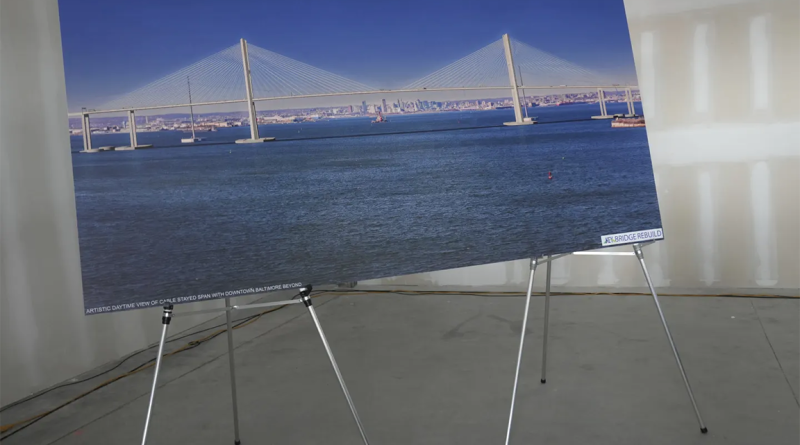Inside the $1.7B Plan to Rebuild Baltimore’s Collapsed Bridge
On March 26, 2024, the Francis Scott Key Bridge in Baltimore collapsed after being struck by the container ship MV Dali. The impact sent large sections of the bridge plunging into the Patapsco River, killing six construction workers and severing a critical transportation link. The disaster disrupted local and national supply chains, increased traffic congestion, and forced businesses to find alternative routes.
In response, state and federal officials vowed to rebuild quickly and safely. Maryland Governor Wes Moore and the Maryland Department of Transportation announced a $1.7 billion reconstruction plan designed to restore this vital infrastructure while implementing advanced safety measures to prevent future catastrophes.
The new Key Bridge a modern cable stayed design
The new Francis Scott Key Bridge will be Maryland’s first highway cable-stayed bridge, replacing the original 1977 steel truss structure. The updated design will feature two towering pylons with radiating steel cables, enhancing both stability and aesthetics.
One of the most critical upgrades is the increased clearance height, rising from 185 feet to 230 feet. This adjustment will accommodate larger vessels and reduce the risk of ship collisions. The cable-stayed design also improves flexibility, allowing the bridge to better withstand traffic loads and adverse weather conditions.
Safety first how Maryland is preventing another disaster
The collapse of the original Key Bridge exposed vulnerabilities in bridge protection and maritime traffic management. To prevent a similar disaster, the new structure will incorporate advanced safety measures designed to withstand vessel collisions and extreme weather events.
A key feature is the installation of an advanced pier protection system. Unlike the previous structure, which had minimal safeguards against ship strikes, the new bridge will include reinforced fenders and impact-absorbing barriers around its piers. These barriers are engineered to deflect or absorb the force of a vessel collision, significantly reducing the risk of catastrophic failure.
The reconstruction plan also includes real-time traffic monitoring and early warning systems for maritime navigation. Enhanced radar and tracking technology will allow port authorities to detect potential threats before they reach the bridge, giving vessels time to adjust course and avoid accidents. Beyond structural reinforcements, federal and state regulations will ensure that large cargo ships follow stricter navigation protocols when passing under the bridge.
Funding and timeline what to expect in the coming years
The estimated cost of rebuilding the Francis Scott Key Bridge ranges between $1.7 billion and $1.9 billion. The federal government has pledged full financial support for the reconstruction, supplemented by insurance claims and lawsuits against the ship’s owner and operators.
The Maryland Transportation Authority has awarded a $73 million contract to Kiewit Infrastructure Corporation for preconstruction and design work. Early stages of the project, including site preparation and foundation reinforcement, began in early 2025.
Full-scale construction is set to begin later in 2025, with completion targeted for October 2028. Officials have emphasized the importance of adhering to this timeline to minimize long-term economic and logistical disruptions in Baltimore.
The economic and community impact of the bridge rebuild
The collapse of the Key Bridge was more than just an infrastructure failure—it was an economic shock to Baltimore and the surrounding region. The bridge served as a vital link for commuters, businesses, and freight transport. Its sudden loss forced companies to reroute shipments, increasing costs and delays. The Port of Baltimore, one of the busiest shipping hubs on the East Coast, saw immediate disruptions in cargo movement, affecting industries from automotive to agriculture.
Rebuilding the bridge is not just about restoring connectivity but also about revitalizing the local economy. The project is expected to generate thousands of jobs in construction, engineering, and related industries. Local businesses, many of which suffered financial losses due to the collapse, anticipate increased economic activity as workers and suppliers return to the area.
For the communities surrounding the bridge, the reconstruction represents an opportunity to modernize infrastructure and improve transportation efficiency. Pedestrian and cycling pathways are being considered as part of the design, enhancing accessibility for non-motorists. Additionally, the project includes environmental initiatives to minimize its impact on the Patapsco River and surrounding ecosystems.
Designed to be stronger, safer, and more efficient, the new Francis Scott Key Bridge reflects Maryland’s commitment to modern infrastructure and proactive disaster prevention. As construction moves forward, state officials and engineers remain focused on ensuring the project meets safety, budget, and timeline expectations. By 2028, the new bridge will not only restore a crucial transportation link, ensuring that it remains a vital part of Maryland’s infrastructure for generations to come.
Sources:
To keep up-to-date with our latest construction news, subscribe to our newsletter today.
